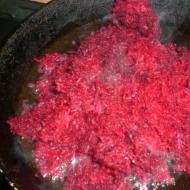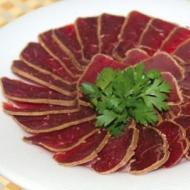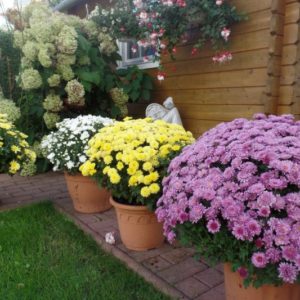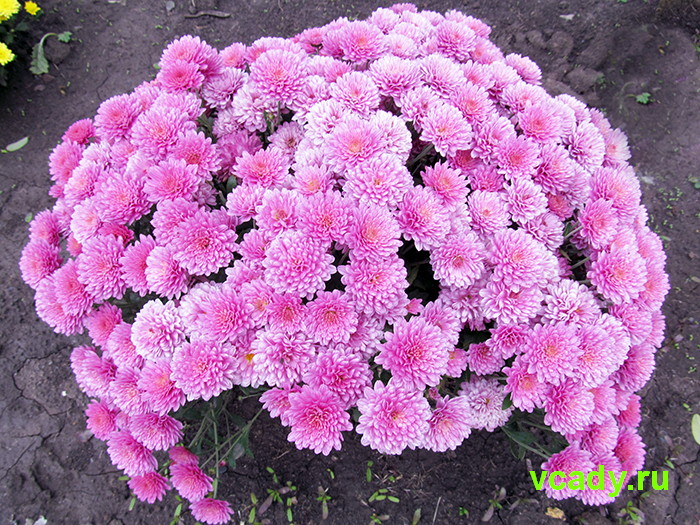
Salvia annual. Salvia: landing and care
The bright red flowers of salvia decorate flowerbeds and lawns in the summer in parks, gardens, courtyards and suburban areas. It is impossible to imagine a flower garden without this beautiful lush plant, which blooms for a long time and is completely unpretentious in its care. Even a novice in floriculture can cope with growing salvia in his garden.
In nature, salvia is a perennial plant, but in our gardens it is grown as an annual or biennial. Some varieties in not very cold and snowy winters can safely winter and bloom for next year.
Salvia bushes can grow up to a meter in height. They have tetrahedral, ascending or erect stems, on which opposite or dissected leaves are located. On top of the leaf plates are dark green and bottom whitish.
Panicled or spicate inflorescences up to 20 cm long form at the ends of the stems. They consist of flowers that can be of very different colors. Salvia is most often grown in culture, sparkling or shining with bright colors. Wild species can range from white to bright purple. 
After flowering on the bush formed consisting of four nuts fruits. About a month later, the seeds of salvia ripen in them, which can be collected and stored. Germination seeds retain for five years.
Varieties and types of salvia - photo
According to the biological characteristics and agrotechnical characteristics of the plant is divided into three types.
First group Representatives of the American subtropics in our climate are grown as annuals. They do not tolerate frost and grow well only on wet soils.
Salvia shiny or sparkling - photo 
Compact bushes with a height of 20 to 80 cm thickly covered with petioles, ovate, whole, opposite leaves. The leaf plates are light green below and dark green above. Crusiform inflorescences ranging in length from 15 to 25 cm are collected from large flowers of irregular shape. Each flower has a double perianth and bright red, pink, purple or white color:
- Salvia sparkling with purple buds different velvety and rich color of flowers. It seems that their petals are downy.
- Varieties with pink flowers do not bloom very long. They have a velvety halo of pink color.
- Salvia brilliant white has a cream corolla and does not bloom very densely.
- Salvia shiny red is characterized by long flowering and dense inflorescences.
Popular among gardeners of a grade of a salviya brilliant:
- Sahara;
- Salvator;
- Red Arrows;
- Fire star.
Flowering salvia sparkling begins in June and continues until the frost.
Mealy salvia - photo
Unpretentious in the care of the plant is a pyramidal shrub in height from 60 to 90 cm. Its oblong-ovate petiole is pubescent along the veins. On high inflorescences dark blue or white buds bloom. On each inflorescence can form from 5 to 30 flowers. They bloom in mid-August and bloom before the onset of cold weather.
Popular varieties of salvia:

Salvia Red - photo 
Medium-sized shrub with branching and pubescent straight stems from 50 to 70 cm high. On the stems there are small, oval, petiolate leaves along the edges. Top sheet plates bare, and pubescent below. The scarlet-red flowers with a long tube form a loose inflorescence, which can be in length from 15 to 30 cm. Flowering begins in July and lasts until the frost.
Popular varieties of salvia red:
- Sherry Blossom - a bush with pink flowers.
- Lady in Red - the variety is distinguished by bright red flowers and up to 40 cm high.
Second group - these are more frost-and drought-resistant types of salvia. They are grown in loose soils rich in mineral fertilizers.
Salvia dandelion 
Herb with not very branching straight stems possesses a rosette of leaves. Incorrectly serrated, pinnately dissected leaf plates are pubescent from the bottom, and from above are bare. Pale pink flowers have a greenish pharynx, covered with purple spots.
Salvia Mutovchataya - photo 
A bush with pubescent ascending or branching stems has a height of up to 40 cm, an unusually shaped pubescent, long-leaflet leaves and flowers with a lilac-blue corolla. Each plant forms a dense whorl, which can form from 5 to 30 buds.
Salvia motley or green - photo 
Wild plant has a decorative appearance - Salvia horminum. This is a bush up to 60 cm in height with brightly colored flowers of pink or lush-purple color. Groomed, oblong-elliptic, petioled leaves are formed on branched, straight stems. The inflorescence up to 30 cm long consists of about six false mutons whose corolla is pink.
Third group - this is Xcold-growing salvia that grow well in temperate climates can grow in the shade, they are unpretentious and require shelter only if a snowless winter is expected. They bloom profusely in the second year after planting in open ground.
Lush Salvia - photo 
A bush with spike-shaped blue-violet inflorescences in height will grow to 60 cm. Popular varieties:
- Rose Queen - a dwarf plant with flowers of pink color.
- Blue Queen - dwarf variety with lavender-blue buds.
- Snow Hill - a bush with white flowers.
Salvia Adhesive - Photo
A tall plant up to 90 cm tall is distinguished by numerous stems with yellowish-green serrate ovate-triangular leaves. At the end of summer, light yellow flowers bloom on the bush. Flowering continues until the end of autumn.
Salvia oak or forest - photo 
Shrub with large purple bracts in length reaches 60 cm. Its sessile upper leaflets are smaller in size than the lower petiolate. Consisting of false whorls inflorescences have two side branches. Each whorl consists of about six flowers with a purple-blue corolla. Buds bloom in late June and bloom before the onset of cold weather. Known varieties:
- Amethyst - a plant with pink-purple flowers.
- Plumoza - bush with dark lavender buds.
- Maynacht - a variety of different purple-blue color of flowers.
Salvia officinalis or sage - photo 
The plant can be attributed to the first group of salvia species, since in nature sage grows in the regions of Asia Minor and the Mediterranean. For more than one thousand years, this medicinal plant is familiar to people and is widely used in cooking, perfumery and medicine.
Sage differs in height up to 50 cm, purple flowers on vertical inflorescences and silvery oblong leaves. It blooms in the middle of summer.
In our gardens, sage is grown as an annual through seedlings.
Growing salvia from seed
Annual and biennial plants breed by seeds, and perennial salvia can be additionally propagated by cutting and dividing the bush.
When to plant salvia on seedlings in 2019?
When to sow salvia? Perennial crops are sown in spring or autumn, and salvia seeds are planted on seedlings from mid-February to early March. Seeding method grow Salvia sparkling or brilliant.
Favorable days on the lunar calendar for planting salvia in 2019:
- February: 7, 11, 13, 16 - the best days, but you can take up the crops 8, 9, 10, 15, 17 and 18. It is not recommended to plant from 3 to 5, 19 and 20.
- March: 10, 12, 15 numbers. You can not sow salvia 5, 6, 21, 31.
- April: from 7 to 18 numbers, but the best days are April 7, 11 and 18. Unfavorable days for sowing: April 5 and 19.
- May: crops - 9, 10, 15, 17. Unfavorable days: May 5 and 19. To plant sprouts salvia on the lunar calendar, you can: 7, 8, 10, 14, 15, 18, 18 May.
- June: the best days for planting seedlings - 4, 5, 6, 12, 13 numbers. It is not recommended to plant on June 3, 11, 17 and 25.
Growing salvia seedlings as follows:
- Prepare rassadny tanks and fill them with a friable damp soil.
- Seeds are buried at a depth of about 2 mm, and the plantings are sprayed with warm water from a spray bottle.
- The containers on top are covered with plastic wrap, resulting in a greenhouse in which the soil does not dry out.
- Crops should be kept warm at a temperature of about +25 degrees. When caring for them, a film is removed every day to air out the soil and check its humidity. Drying soil moistened with a spray bottle.
Seedling care
After about two to four weeks, seedlings will appear. To seedlings form a strong root system, before planting in an open ground bushes swoop twice.
The first pick is made after the appearance on the seedlings of two true leaves. They are seated from each other at a distance of 5 cm, using for this purpose a rassadnuyuyu capacity of larger.
The second time the seedlings swoop in three weeks after the first picking procedure. In this case, each bush will need an individual pot with a diameter of 10-12 cm. 
In order for plants to better bush, when a third or fourth true leaf appears, their tops are pinched.
In the middle of spring at night, seedlings are exposed to a closed loggia with air temperature up to +10 degrees. Thus, the plants are hardened and prepared for planting in open ground. If there is no loggia, the hardening can be carried out by airing the room or taking out seedlings in warm weather during the day outside.
For the plant is preparing a flower bed, located on a well-lit area, otherwise their flowering will be scarce. In the partial shade only salvia can grow.
When to plant salvia in open ground?
Seedlings are planted in early June, when even at night the positive temperature will be established. Before landing prepare the wells with a distance  25-30 cm apart. The soil should be permeable, sandy and light, rich in humus and lime.
25-30 cm apart. The soil should be permeable, sandy and light, rich in humus and lime.
The bottom of the hole is filled with humus, after which a bush is placed on it with a clod of earth. Roots sprinkle with soil and water.
How to grow salvia?
The plant is unpretentious and does not require special care throughout the season. But some of the nuances of growing it need to know:

Leaving after flowering
Salvia blooms from early summer until frost. Each species has its own flowering strings. If salvia forest trim and feed as soon as it fades, then at the end of summer, you can wait for a new bud formation.
Perennial salvias are cut off after flowering, and the soil around them is covered with mulch. Be sure to cover garden growth point compost. Young plants additionally cover themselves with dry foliage or spruce leaves.
Diseases and pests
Salvia is infrequently affected, and among the pests, ticks, aphids, thrips or whiteflies can live on it. Tender foliage plants like to eat snails and slugs.
Insect pests are destroyed by spraying the bushes with special insecticidal preparations. Slugs or snails are harvested by hand. 
Bright salvia flowers combine well with decorative leafy and flowering plants. They can be used to create multi-tiered flower beds and flower beds with complex floral patterns. Unpretentiousness of flowers allows them to be planted in parks and city beds. Salvia can be planted in a garden container or box and decorated with a balcony. In the garden, it can be grown almost anywhere, most importantly, show imagination.
Flower Salvia has another name - Sage and is a perennial, long-flowering medicinal plant, which today there are about 400 species. It is not only beneficial, but also aesthetically pleasing. Many designers use Salvia to create original and unusual flower beds. If you also decide to plant this flower, you probably want to know: how to do it properly and what kind of care it needs? Salvia red, photos of flowers are presented on our website, really decorate your garden bed.
Salvia red, photo of flowers
Salvia red - seed germination
Many gardeners plant Salvia only for therapeutic purposes. From the leaves of the plant, you can make tinctures that help fight diseases of the throat, kidneys and gums. Sage will quickly eliminate toothache and stop bleeding. Leaves should be torn in the spring before flowering or autumn. A wide variety of varieties will help everyone to choose the most appropriate to his taste preferences. Sylvia is presented in different shades: pink, purple, blue, yellow and red.
 Varieties silvia
Varieties silvia As for cultivation and care, Salvia is not a demanding plant, it adapts quickly and grows rapidly. The main condition for good development is sown seeds on time. Where to get quality planting material? Experts advise to give preference to stores rather than markets. The only way you can be sure that you will not be disappointed when the plant starts to grow.
 Sylvia Seeds
Sylvia Seeds Seeds, before planting in open ground, germinated. It is recommended to do this in the month of February, but not later, since it is too dangerous to plant seedlings with extreme heat. How to sow Salvia seeds? This will require a small container or container, at the bottom of which a small drainage system is laid in the form of expanded clay or small crushed stone. Top soil substrate is filled up, which can be purchased at any store. Now you need to thoroughly moisten it, cover with glass or plastic wrap and leave for 24 hours. Anyone who has ever seen Salvia seeds will not deny that they are very tiny, so it is recommended to mix them with a small amount of sand before sowing. After the mixture is evenly scattered on the substrate, lightly pressed against the palm and irrigated with a spray bottle. Capacity again covered and put in a dark place until the first shoots.
 Growing Sylvia seedlings, photo
Growing Sylvia seedlings, photo Important! As soon as you see that the seeds have started to germinate, you can remove the film or glass and put the container on the sunny windowsill, providing additional lighting. Now the main thing is to ensure that the soil is sufficiently wetted so that it is not very wet and overdried. Ash can be used as a fertilizer.


Planting Salvia in open ground and proper care
Sage is not very picky about growing conditions, but some points will have to be taken into account:
- Location. The flower loves open, sunny places, without strong shadow.
- The soil. The soil should be loose, light and nutritious. To do this, you can mix the top layer of soil with peat or other substances.
- Fertilizer. When planting, you can use liquid mineral fertilizers that are poured to the bottom of the hole.
The sapling will start quickly and after a short time it will delight you with its flowering. As for the care, Salvia needs only regular and constant watering, otherwise the root system will quickly disappear. It is also necessary to loosen the soil, remove the weed and spray the plant in case of pests or diseases.

So, Salvia is red, photo of flowers which you can see on our site will be a worthy decoration of your summer cottage. We hope that our advice will help you transform your territory, make it original and unusual.



Not everyone has the patience to grow salvia seedlings on their own. Indeed, after sowing, it takes 3 to 4 months before the first flowers appear on the plants. However, growing salvia from seed is quite simple. It is only necessary to take into account that there are so many varieties of this plant, which differ greatly from each other both in color and in growth.
Salvia height depending on the variety, it can be from 25 cm and up to 1,5m. Therefore, it is necessary to carefully choose the seeds that would get exactly the sort that you need.
What does salvia look like
  |
  |
How to choose a primer
The seedling will grow well on light, fertile soil with a pH of 6.0 - 6.5. It can be prepared by mixing the ground from the forest with sand and peat 1: 1: 1. Or buy any soil mixture for growing seedlings.
When to sow
Sow Salvi on seedlings preferably in February or March. Then it will bloom in early summer. But hybrid varieties bloom much earlier. When buying seeds, be sure to read what is written on the package.
Spread the seeds on well-spilled soil, lightly sprinkle with earth and sprinkle from the top of Rosinka. Cover the box with glass, film or newspaper. Now many people use newsprint. It retains moisture, and at the same time passes air.
Sometimes there are recommendations, do not fill the seeds with earth, but simply palm them into the ground. With such a crop, many sprouts appear with a seed coat on the "head". And you have to manually help them get rid of these "caps"
Seeds germinate at a temperature of +22 - 24C. Shoots usually appear after 7 - 10 days. Unfortunately, they are often unfriendly. The last shoots sometimes make their way when all hopes of seeing them are already lost.
Seedling care
To grow salvia from seeds, you need a well-lit place where the temperature does not exceed 18 - 20C. If you have a free window sill, then it is quite suitable for this. After 
 emergence of seedlings remove the film, and a day later you can put a box with seedlings on the windowsill.
emergence of seedlings remove the film, and a day later you can put a box with seedlings on the windowsill.
Water only with warm water and very moderate. With an excess of moisture, seedlings may be affected by the black leg. Before planting in open ground, spend two dressings full floral fertilizer.
Picking
Salvia seedling grows slowly. Therefore, the picking is carried out in 1 - 1.5 months after germination. Plants are transplanted into cups or boxes at a distance of 6 - 7 cm from each other, with their deepening to the cotyledon leaves.
Planting seedlings in the ground
In the ground Salvia planted in early June. She prefers open, sunny places with light soil. But it can grow in the shade and even under the trees. Before flowering plants should be watered more often, and less often during flowering. Then there will be more flowers. Do not abuse nitrogen supplements. Shrubs can "fatten" and will bloom badly.
Breeding 

Every year summer brings to the earth a lot of heat, which all plants need without exception. It is necessary for flowering and ripening of seeds, which are destined to replace the past generation. Salvia at this stage of development is represented in the form of a panicle of tubular flowers, which in the midst of summer insects with long proboscis known to all begin to pollinate. These flowers can not help but delight the gardener, who decided to plant them on the site. However, this business is rather complicated and not well known to everyone; therefore, many people often make mistakes.
The origin and cultivation of salvia
The photo of a plant can be surprising, because it is unfamiliar to ordinary summer residents. However, experts are well aware of its features.
Salvia is a close relative of sagethat represent the family of yasnotkovyh. If you try to translate the name of the plant, it will be clear about its purpose - to be healthy. Sage refers to a group of traditional plants, about the useful properties of which people learned many centuries ago. Even in the times of ancient Egypt, it was used to combat various ailments. Salvia is one of the decorative forms that originated, like sage, from common ancestors. However, in European countries it has long been accepted to identify salvia and sage.
From the moment when a person first learned about the existence of a plant, they began to actively cultivate it in various forms. The largest representation of salvia in the wild has in America and Europe. The genus Salvia is quite numerous and includes more than 900 different varieties. There are quite interesting species in this list, for example, a hallucinogenic variety. This is a very light-loving plant that grows best on light soils.
In recent years in cities for street decoration often use salvia, which can be explained by several reasons:
For a long time all over the world gardeners practice growing salvia at home. In this perennial plant they are attracted not only by the bright scarlet color of the panicles, but also by the rich color palette. If you wish, you can arrange a multilevel landingif you use salvia species of a certain height. However, in order for this plant to retain its beautiful flowers as long as possible, it is necessary to approach the process of growing seedlings correctly.
Salvia: photos of flowers, seedlings when planted?
Considering that at least 4 months must pass from the moment of emergence of shoots before salvia begins to bloom, it is necessary to sow seeds for seedlings of this one-year plant already in February or early March. For the purchase of seeds of this ornamental plant, you can contact a specialized store or collect them yourself. For this you need wait for the flowers to wither and fall off, and after 50 days you can collect fully ripened seeds. This planting material is suitable for sowing over the next five years.

Care for the seedlings of salvia flowers
 When the seeds begin to spit up, you need to do everything necessary so that the plants do not begin to stretch into a thread and do not fall. Usually this happens if the sprouts are kept in a shaded place or room where night occurs high temperature rise. In this case, the plants need to sprinkle with an additional amount of earth to protect them from falling.
When the seeds begin to spit up, you need to do everything necessary so that the plants do not begin to stretch into a thread and do not fall. Usually this happens if the sprouts are kept in a shaded place or room where night occurs high temperature rise. In this case, the plants need to sprinkle with an additional amount of earth to protect them from falling.
You need to be very careful during watering, avoiding wet leaf blade. This period is one of the most important when growing seedlings of salvia from seeds. In order to obtain strong seedlings, it is necessary at the first stage of planting to conduct additional lighting and to maintain a lower temperature.
Salvia seedlings dive at the moment when the seedlings form at least two true leaves. During transplantation it is absolutely necessary deepen sprouts to the first cotyledon leaves. The first time the plants are transplanted into a common container, placing them no closer than 5 cm from each other. The second time the seedlings swoop after a month, using individual cups. They must be filled with high-quality pochvosmesyu, transplanted seedlings need with a sufficient amount of earthen coma, because they have to grow for at least one and a half months.
To understand whether there is a need for fertilizer when growing seedlings, it is possible only over time. If it can be seen that seedlings grow very slowly, then fertilizing mineral compositions for flowers, which need to be made in small quantities, will be useful. However, the main thing that needs to be understood is that every time a transplant is carried out, the plants dive in a container with fertile soil.
The formation of seedlings 3-4 pairs of true leaves is signal to pinch the tops. This operation will help accelerate the formation of axillary shoots. At this stage of the seedling life cycle, it must be placed at a certain interval to eliminate shading. In late April, the night temperature should be lowered to 10 degrees, which will help prepare salvia for landing in open ground.
You can get quality seedling salvia from seeds, if you follow the following recommendations:
- the soil used for growing seedlings must be fertile and the seeds must be of high quality;
- it is necessary to maintain the optimum temperature and light conditions, taking into account each specific growth period;
- constantly monitor the state of the earth’s coma and, if necessary, moisten;
- to pinch the plants at the moment when it is required for salvia.
Planting salvia seedlings in the ground
 Before transplanting this perennial plant in open ground find the right place for a bed. Mandatory requirements that must be met by the site - the presence of good lighting, light fertile soil with excellent water-holding capacity. It is possible to increase the splendor of flowering by introducing instant phosphorus-potassium fertilizers into the soil. Before transferring the seedlings to the wells, they add a handful of ash, a spoonful of superphosphate and a liter of well-rotten organic matter.
Before transplanting this perennial plant in open ground find the right place for a bed. Mandatory requirements that must be met by the site - the presence of good lighting, light fertile soil with excellent water-holding capacity. It is possible to increase the splendor of flowering by introducing instant phosphorus-potassium fertilizers into the soil. Before transferring the seedlings to the wells, they add a handful of ash, a spoonful of superphosphate and a liter of well-rotten organic matter.
Planting is carried out by the method of transshipment, the plants themselves. need to deepen a little. After watering, for which warm water must be used, plants need to create an artificial shade for a couple of days in order for them to settle down if it is not possible to perform a transplant in cloudy weather.
Conclusion
Salvia is a worthy decoration for any garden. However, in order to grow it, you need to spend a lot of time and effort on growing seedlings. This technique allows you to get strong and hardened plants that easily take root in open ground. But the success of this event can be completed only if all conditions are met. The most important thing is to properly prepare for the cultivation of seedlings, since it is they who determine the future quality of the plants.
Salvia flower brilliant



















